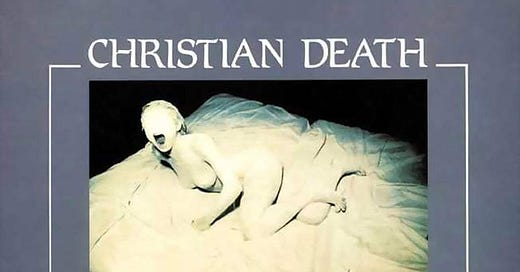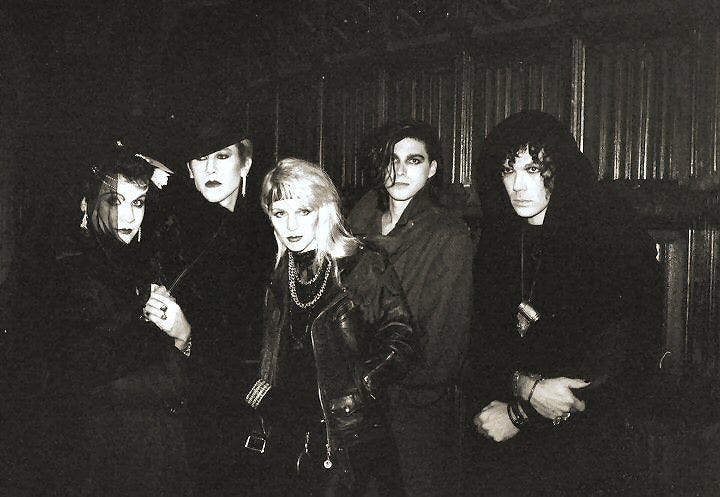Christian Death - Catastrophe Ballet (1984) album review
Happy World Goth Day to all who celebrate! In honor of this blessed day, here's a review of Christian Death's essential second album, Catastrophe Ballet.
Christian Death's second album is an ur-document of '80s Goth, giving equal voice to arty 70s post-punk and the death rock and dark pop to come.
Hauntology Now! is the Substack of interdisciplinary artist, designer, musician, academic writer, and cultural critic J. Simpson, where he writes about all things hauntological, atemporal, philosophical, as well as sharing thoughts, reflections, and musings on music, movies, books, and life.
The earliest Goth records were rooted in the arty, gloomy late '70s post-punk, to the point that they're often interchangeable. The earliest classic Goth records are heavy on atmosphere and concept. Accessibility, on the other hand, is another story. You're far more likely to get a 7-minute atonal guitar noise solo while Peter Murphy solemnly intones Baudelaire or J. K. Huysman than anything resembling a verse/chorus, hook or even, dark Gods forbid, a hummable melody.
As Gothic Rock evolved into a genre and a global subculture in its own right over the span of the '80s, it would take on a much more accessible shimmer and sheen, especially once it crossed the dark waters of the Atlantic Ocean, planting its dark roots in expansive American soil.
Christian Death were early acolytes of a new, burgeoning Goth scene, flourishing in the unlikely landscape of Los Angeles, despite its deserts and perennial blue skies, its blazing sun and beautiful people. Instead of glassy, rain-soaked streets and New Romanticism, SoCal Goth - which tends towards the style known as Death Rock - draws upon vintage Hollywood glamour, Universal Monsters campiness, and LA's ubiquitous sense of style, hedonism, and excess to create a brighter, more enticing, alluring take on Gothic Rock.
On their second - and some say their best - album, Christian Death create an artifact of timeless, seductive beauty by focusing on the roots of Gothic culture as much as its poisonous new blossoms. Like Siouxsie and the Banshees before them, Christian Death draw upon cerebral arthouse horrors like The Cabinet of Dr. Caligari or Carnival of Souls more so than the Slasher schlock of their day. They augment the steely post-punk of their debut, Only Theater of Pain, with an organ that ranges from the funereal to the carnivalesque to the psychotic. Honestly, if you like dark, horror-soaked punk and rock 'n roll, it should be enough to say Catastrophe Ballet sometimes sounds like The Cramps backed by the 13th Floor Elevators organist creating damned, doomy soundtracks for German expressionism. What more do you really need to hear?
Catastrophe Ballet finds Christian Death recording with a whole new line-up apart from singer Rozz Williams. It's the first to include the musically divisive Valor Kand, who would later go on to usurp the Christian Death name. It's also the first to include Gitane Demone, who would become integral to not only Christian Death's sound, with her freezing banshee wail, but also their overall look and aesthetic, which is nearly as important to the band's enduring legacy.
The ghosts of Goth past, present and future are present on the album's opening two tracks, which would qualify Christian Death as one of the greatest Goth bands of all time even had they never recorded another note. "Awake at the Wall" is oblique, subtle, strange, and surreal, coming on like Brian Eno producing Suicide while Williams intones neo-romantic poetry and the rest of the band produce slippery shards of eel-like atonality. "Sleepwalk," on the other hand, returns the band to their steely, speedy Death Rock roots, sounding like a great early Bauhaus single, with glistening flanged guitars and Demone's valkyrie vocals. The doomy half-time breakdown is where you cock a perfectly manicured eyebrow, though. They sound like punks and look like fallen angels but that one minute makes one thing explicit - Christian Death can play.
If you like Goth rock or dark post-punk, those two tracks alone are likely enough to make you a Christian Death fan. It's the perfect bridge from the gloomy, existential early Goth of Joy Division and The Cure to the sleeker, more polished, poppier '80s Goth of bands like Sisters of Mercy or Sex Gang Children. '80s Goth can definitely yield some uneven results, so it's well worth it to start towards the beginning to have a better sense of what's what.
Catastrophe Ballet is not a perfect record. The next two tracks, "The Drowning" and "The Blue Hour," both feel relatively minor, thanks in no small part to fairly lackluster production. Things pick back up with the killer triple-header of "As Evening Falls," a career highlight; "Androgynous Noise Hand Permeates," with its toppling Tower of Babel percussion; and especially "Electra Descending," which sounds as good as anything Mssrs. Bowie or Murphy ever laid to tape. Catastrophe Ballet would be an essential Gothic record for "Electra Descending" alone.
It's more than worth your time to develop the palate, though, as there's a wonderland of experimental '70s/'80s avant-garde beauty to get lost in, once you find your way into the dark woods.
You can also find Catastrophe Ballet on our Classic Gothic Rock Albums playlist:
What are some other classic Goth albums you'd like to see reviewed? Let us know in the comments or get in touch via Twitter, Instagram, or BlueSky,
This post originally published on Forestpunk.
Want More Goth?
Follow @for3stpunk on Twitter, Instagram, BlueSky, TikTok, Letterboxd, Trakt TV, Goodreads, and Pinterest, and drop by the Facebook page!





